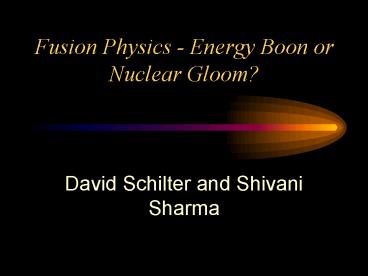Fusion Physics Energy Boon or Nuclear Gloom - PowerPoint PPT Presentation
1 / 11
Title:
Fusion Physics Energy Boon or Nuclear Gloom
Description:
The spectrometer measures intensity near this wavelength, providing a wavelength ... moving toward and away from spectrometer. H -line 'knee' Results Continued... – PowerPoint PPT presentation
Number of Views:169
Avg rating:3.0/5.0
Title: Fusion Physics Energy Boon or Nuclear Gloom
1
Fusion Physics - Energy Boon or Nuclear Gloom?
- David Schilter and Shivani Sharma
2
Problem Statements...
- Is it possible to construct a potential array
(electrostatic potential well) which would allow
for resulting energy close to or exceeding
applied voltage? - What electrode configuration in an IEC device can
both avoid energy loss due to space charge as
well as encouraging ion acceleration? - Would the idea of circulating ions provide a
solution to the problems of space charge while
also inducing nuclear fusion?
3
Plasmas
- AC grid causes radio frequency discharge which
creates oscillating B and E ? ionizes the
hydrogen gas used to create a plasma, a mixture
of high energy ions and electrons - Diffuses into a chamber that also contains a
neutral hydrogen background gas, which is not
affected by the electrodes
4
Experimental Setup
- Inner spectacle (?22mm) ? cathode
- Outer mesh ? anode (earthed)
- Pressure maintained at 5mTorr (7x10-6 atm)
- Magnetic field was set at 70 gauss (7x10-3 T)
- Voltages of 1-10kV applied to cathode
5
Electrode Geometry
6
Some theory...
- The H? line (656.3nm) represents the first atomic
transition in the Balmer series (from n3 to n2) - 1/? RH(1/2)2 - (1/n)2 where
Rydbergs constant RH 1.0968x107m-1 - The spectrometer measures intensity near this
wavelength, providing a wavelength distribution. - Fusion cross-section (probability) of 1H is many
orders of magnitude less than deuterium (2H) or
tritium (3H)
7
Charge-exchange Reactions
- Charge exchange reactions occur as fast, ionized
plasma collides with stationary background gas - In all cases, the high energy plasma becomes
unstable due to the exchange and fragments - This results in the excited radical H which is
detected by the spectrometer
- H H?H H
- H2 H ? H H H
- H3 H ? H H2 H
- H H2? H H2
- H2 H2 ? H H H2
- H3 H2 ? H H2 H2
8
Observations
- Very slight circulation of ions observed between
two rings, which were red hot - Majority of ions passed through, and continued in
a roughly linear path, which created beams - Purple colour characteristic of high energy
hydrogen
9
Energy Distributions
- Shifts involved are characteristic of the various
charge-exchange reactions - The knee relates to the most energetic ions
- Intense alpha line is due to background gas
- Note symmetry?ions moving toward and away from
spectrometer
10
Results Continued...
- Energy plotted against voltage results in a
linear relationship - It was also found that that B had no effect on
the maximum ion energies - Efficiencygradient, which in this case is
approximately 7
11
Conclusions
- Excited and Doppler shifted atoms were observed
at wavelength up to 0.89nm greater than that of
the H? line (?o656.3nm) corresponding to
energies of 8.7x10-1keV - Efficiency of 7 clearly too low?new grid design
- B not strong enough to induce circulation in a
large proportion of the ions - Ions accelerated from each direction rather than
in a circular motion to avoid the virtual anode - The simulation of the exact same conditions were
undertaken and discrepancies accounted for...































